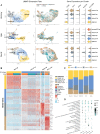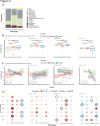Role of synovial fibroblast subsets across synovial pathotypes in rheumatoid arthritis: a deconvolution analysis
- PMID: 34987094
- PMCID: PMC8734041
- DOI: 10.1136/rmdopen-2021-001949
Role of synovial fibroblast subsets across synovial pathotypes in rheumatoid arthritis: a deconvolution analysis
Abstract
Objectives: To integrate published single-cell RNA sequencing (scRNA-seq) data and assess the contribution of synovial fibroblast (SF) subsets to synovial pathotypes and respective clinical characteristics in treatment-naïve early arthritis.
Methods: In this in silico study, we integrated scRNA-seq data from published studies with additional unpublished in-house data. Standard Seurat, Harmony and Liger workflow was performed for integration and differential gene expression analysis. We estimated single cell type proportions in bulk RNA-seq data (deconvolution) from synovial tissue from 87 treatment-naïve early arthritis patients in the Pathobiology of Early Arthritis Cohort using MuSiC. SF proportions across synovial pathotypes (fibroid, lymphoid and myeloid) and relationship of disease activity measurements across different synovial pathotypes were assessed.
Results: We identified four SF clusters with respective marker genes: PRG4+ SF (CD55, MMP3, PRG4, THY1neg ); CXCL12+ SF (CXCL12, CCL2, ADAMTS1, THY1low ); POSTN+ SF (POSTN, collagen genes, THY1); CXCL14+ SF (CXCL14, C3, CD34, ASPN, THY1) that correspond to lining (PRG4+ SF) and sublining (CXCL12+ SF, POSTN+ + and CXCL14+ SF) SF subsets. CXCL12+ SF and POSTN+ + were most prominent in the fibroid while PRG4+ SF appeared highest in the myeloid pathotype. Corresponding, lining assessed by histology (assessed by Krenn-Score) was thicker in the myeloid, but also in the lymphoid pathotype + the fibroid pathotype. PRG4+ SF correlated positively with disease severity parameters in the fibroid, POSTN+ SF in the lymphoid pathotype whereas CXCL14+ SF showed negative association with disease severity in all pathotypes.
Conclusion: This study shows a so far unexplored association between distinct synovial pathologies and SF subtypes defined by scRNA-seq. The knowledge of the diverse interplay of SF with immune cells will advance opportunities for tailored targeted treatments.
Keywords: arthritis; fibroblasts; rheumatoid; synovitis.
© Author(s) (or their employer(s)) 2022. Re-use permitted under CC BY-NC. No commercial re-use. See rights and permissions. Published by BMJ.
Conflict of interest statement
Competing interests: None declared.
Figures




References
MeSH terms
Grants and funding
LinkOut - more resources
Full Text Sources
Medical
Miscellaneous
